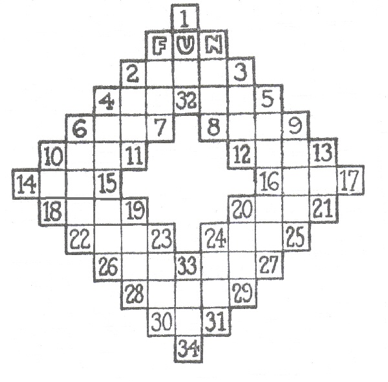Crossword Puzzle

First called a word-cross puzzle.
A new game was introduced to readers of the New York World on December 21, 1913. It was created by Arthur Wynne, who was employed in the newspaper’s ‘tricks and jokes department’. Wynne was from Liverpool, England and had the idea from a Victorian parlor game that his grandfather used to play, called Magic Squares. The clues to these early puzzles were not difficult, being mainly word definitions. Give it a try and if you don’t succeed email the Journal for the answers.
2 – 3. What bargain hunters enjoy.
4 – 5. A written acknowledgement.
6 – 7. Such and nothing more.
10 – 11. A bird
14 – 15. Opposite to less.
18 – 19. What this puzzle is.
22 – 23. An animal of prey.
26 – 27. The close of a day.
28 – 29. To elude.
30 – 31. The plural of is.
8 – 9. To cultivate.
12 – 13. A bar of wood or iron.
16 – 17. What artists learn to do.
20 - 21. Fastened.
24 –25. Found on the seashore.
10 -18. The fiber of the gomuti palm.
6 – 22. What we all should be.
4 – 26. A day dream.
2 – 11. A talon .
19 – 28. A pigeon.
F – 7. Part of your head.
23 – 30. A river in Russia.
1 – 32. To govern.
33 - 34. An aromatic plant.
N – 8. A fist
24 – 31. To agree with.
3 – 12. Part of a ship
20 – 29. One
5 – 27. Exchanging
9 – 25. To sink in mud.
13 – 21. A boy.
It wasn’t long before the puzzle took the form of a grid with black squares separating the words. The black squares are traditionally limited to one-sixth of the design. Another tradition in puzzle design (in North America and Britain particularly) is that the grid should have 180-degree rotational symmetry, so that its pattern appears the same if the paper is turned upside down. Puzzles are often one of several standard sizes. For example, many weekday puzzles (such as the New York Times crossword) are 15×15 squares, while weekend puzzles may be 21×21, 23×23 or 25×25.
The first book of crossword puzzles appeared in 1924, published by Simon and Schuster. The book was an instant hit and crossword puzzles became the craze of 1924. The term crossword first appeared in a dictionary in 1930. The most prestigious (and among the most difficult to solve) are the New York Times puzzles, which have been running continuously since 1942.
